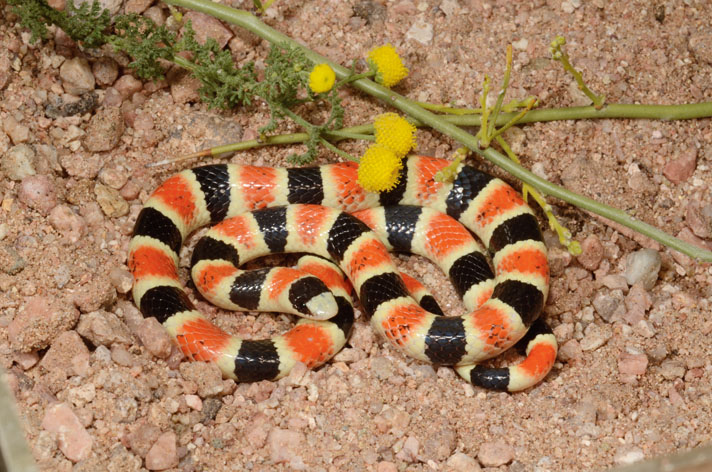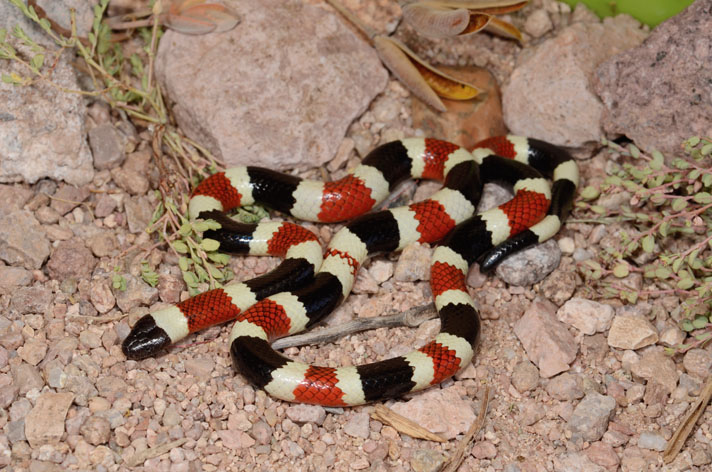Coral Snake Red On Black Friend Of Jack
The rhyme — red touches yellow, kills a fellow, red touches black, friend of Jack - doesn't work in every case, and that's we do not recommend using it as a reliable way of identifying venomous or dangerous snake species. “Red and black, friend of Jack; red and yellow kill a fellow.” The rhymed mnemonic above refers to snakes with tri-colour pattern of red, black and yellow bands in North America. The order of the colours on these snakes could help identify if they are deadly or not. This rule dos not always work for every breed of Coral Snakes, for example the 'Micrurus frontali' breed of coral snake color pattern is: red, black, yellow, black, yellow, black, red. On this species, red touches black but it is very much poisonous. “Red touch black, friend of Jack.” Like the coral snake, it prefers drier habitats. It also tends to be larger, both thicker and longer, than the average coral snake. It will bite if you disturb it – all snakes will bit if they feel threatened – but the kingsnake non-venomous.
Need snake removal in your hometown? We service over 500 USA locations! Click here to hire us in your town and check prices - updated for year 2020.
One of the things that separates human beings from any other animal on the planet is their ability to create acronyms and pneumonic devices that help them to be able to memorize key pieces of information. This is used by biologists to remember the classification system, soldiers to remember ranks, and astronomers to remember the different galaxies.
However, the ability to use memory devices like this are not limited to pneumonic and acronym options. One of the best ways to remember something is through the use of a story or poem. Because of the manner in which they are written they can become very useful techniques to be able to help a person to remember important dates, like the War of 1812 or Paul Revere's ride.
One that has become quite successful in helping people to identify snakes is a poem that was written that not only tells how one can identify if something is a coral snake, King snake, or Florida scarlet snake, but whether those snakes are venomous to people.
It is a beautifully written poem based on the three primary colors of these animals: read, black, and yellow. What is so amazing about this poem is that it accurately depicts the exact way that a person is able to tell which one of these snakes a person comes upon, and whether that snake is poisonous or venomous to you.
Because of the fact that the coral snake is quite venomous and extremely dangerous to you, it is important to be able to distinguish it from the other two kinds of snakes, especially when you only have a few moments to be able to make a determination. This poem is written beautifully to ensure that you can do just that. It isn't written in any kind of like the pentameter, like you are reading a story from Homer, but is instead written so that you can make a quick decision about whether this snake is to be of concern to you or not.
According to the tail, this rhyme was first created in 1862 by a man known as “Fat” Jack Loticus. While there have been variations of it that had been developed over the years, the fact remains that this poem has been helpful for over 150 years in helping people to be able to identify what kind of snake they are looking at.
While it is clearly a great way to learn how to identify the snake, what separates it and makes it such a beneficial tool is that it helps children to be able to learn more about the world around them. The fact remains that the more that we understand our ecosystem in the different species of animals that live within it, the better off we are in the better it is for the ecosystem itself. We all live together in this big blue marble in the sky, and it makes sense to be able to get to know our fellow species on this planet a little better.
Here is that poem in its entirety.
Red touches yellow, kills a fellow. Red touches black, friend of Jack
Red touch yellow, kills a fellow. Red touch black, venom lack.
Red touch yellow, death says hello. Black touch red, keep your head.
Yellow touch red, you be dead. Red touch black, eat Cracker Jack.
Red and yellow mingle, bite feel a tingle. Red and black hug, sing a song, you lug.
Red and yellow cohabitate, soon you will suffocate. Red and black together, in for sunny weather.
Red leans on yellow, legs turn to jell-o. Red leans on black, keep a strong back.
Yellow brushes red, snake gets fed. Red brushes black, snake gets no snack.
Snake of black and yellow and red, soon a stupid rhyme is said.
Need snake removal in your hometown? We service over 500 USA locations! Click here to hire us in your town and check prices- updated for year 2020.
The snake poem — red touch yellow killed a fellow — commonly refers to two snakes that look very much alike. One of them is venomous and one of them isn't. The rhyme helps you to work out which one is which and, hopefully, prevent yourself from becoming a snake dinner. Or, at the very least, a snake victim.
The coral snake is the actual venomous snake, although various other snakes try to mimic the bright patterns and colors to make themselves look more frightening to predatory attacks. The Florida scarlet snake is a prime example of this, and another is the scarlet king snake. The shovel-nose snake is another non-venomous snake that is often confused with a venomous snake, but sadly this rhyme doesn't work in this case. In both species of snake, the red bands are touched by the yellow bands. This makes the shovel-nose snake appear venomous even when it is not, but that's not a bad thing. You'll be more inclined to steer clear, and we'd highly recommend that with ANY species of snake, whether you think it's a venomous one or not.
There is another case where the rhyme doesn't work, and in this case, the fact that the rhyme doesn't work actually makes it incredibly dangerous. The South American coral snake has black bands that touch red bands, which would make them seem entirely harmless. This is NOT the case. The South American coral snake is venomous and should be avoided at all costs.
The rhyme — red touches yellow, kills a fellow, red touches black, friend of Jack - doesn't work in every case, and that's we do not recommend using it as a reliable way of identifying venomous or dangerous snake species.
Although there are ways that you can identify venomous from non-venomous snakes, the tricks and tips aren't entirely foolproof and there will always be cases where there are exceptions to the rule. If you are faced with a snake on your property or in your home, don't get close enough to it to work out what kind of snake it is. Try to keep the creature confined to one room and call for help. This is not the kind of job you'll want to tackle on your own.
For more information, you may want to click on one of these guides that I wrote:
How much does snake removal cost? - get the lowdown on prices.
How to get rid of snakes - my main snake removal info guide.
Example snake trapping photographs - get do-it-yourself ideas.
Snake job blog - learn from great examples of snake jobs I've done.
Coral Snake Red On Black Friend Of Jack Reacher
Having the second most potent venom of any snake, the coral snake is not only beautiful but deadly! These beauties can be found in the southwest, southern, and southeastern United States, as well as Mexico. These venomous snakes would much rather slither away than confront a predator. They will stand their ground though, if given no other option to escape. These critters are highly venomous, but no deaths have been recorded in recent years.
First the Stats…
Coral Snake Red On Black Friend Of Jack Hibbs
Scientific name: Chordata
Weight: Up to 8 – 16 ounces
Length: Up to 24 inches
Lifespan: Up to 7 years

Now on to the Facts!
1.) These snakes are primarily nocturnal (active at night) but can also be crepuscular (active at dawn and dusk).

2.) Coral snakes brumate (hibernation for reptiles) during fall and winter.
3.) They prey on amphibians and reptiles primarily.
4.) Their predators are typically nocturnal animals like owls, badgers, and raccoons.
5.) Their heads and tails are typically black. This helps to cause confusion for predators. As they aren’t sure which is the business end.
But wait, there’s more on the coral snake!
6.) The coral snake’s venom is a highly potent neurotoxin.
7.) Production of antivenom has been stopped since 2010! So, basically, don’t get bitten. Leave them alone and they’ll leave you alone.

Did you know…?
When threatened, coral snakes will sometimes make a popping sound by pushing air from their cloaca (a single opening for the urinary, reproductive and intestinal tract) to startle the attacker. Yep, these snakes fart when threatened.
8.) One, not so accurate method of telling if you’ve encountered a coral snake is the saying “red touches black, friend of Jack. Red touches yellow, kill a fellow.” Again… not the best way to tell if a snake is venomous. The best approach is not to approach. Appreciate it from a far. Take a picture or two and leave it alone.
9.) One myth states that they are rear fang venomous and have to bite and gnaw on you till they work the bite to the back of their mouth, where the fangs are. Not true.

10.) Another myth is that they have to bite you on the webbing of your fingers in order to inject venom. Also not true. They can get you on the finger or hand, just as well and then you’ll wish you hadn’t messed with them.